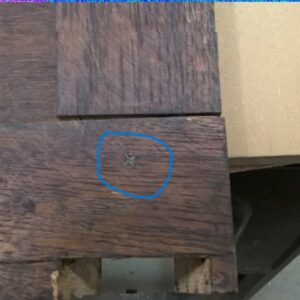I’m disassembling an older piece of furniture and the back panel stiles and rails are assembled with mortise and tenon corner joints with what I assume is a star shaped fastener. See attached picture.
How do I remove it. Need to replace one of the stiles.
Discussion Forum
Get It All!
UNLIMITED Membership is like taking a master class in woodworking for less than $10 a month.
Start Your Free TrialCategories
Discussion Forum
Digital Plans Library
Member exclusive! – Plans for everyone – from beginners to experts – right at your fingertips.
Highlights
-
Shape Your Skills
when you sign up for our emails
This site is protected by reCAPTCHA and the Google Privacy Policy and Terms of Service apply. -
 Shop Talk Live Podcast
Shop Talk Live Podcast -
 Our favorite articles and videos
Our favorite articles and videos -
E-Learning Courses from Fine Woodworking
-
-
 Fine Woodworking New England Event
Fine Woodworking New England Event -













Replies
2 questions:
Is it metal, and is it visible on the other side?
My first try if it is not visible would be to measure carefully and try a punch from the back to poke it out. If you don't want to disturb the surface you could try a thin multi-tool blade from the outside edge to cut it and fill the slot/ slots later... aim for the inside surfaces of the mortise walls. A pretty invisible fix on a back panel. a plug cutter from the back could get you there also.
This is on the back side and is metal and is not visible on the other side. It appears to be a fastener in lieu of gluing an M & T joint.
How about trying to remove it with one of these: https://www.rockler.com/screw-extractor
They heat up quickly so go slow so let them cool
I like mj's questions. Is it a hammer in, or a screw in?
My guess is hammer in, because I see no driver marks. So, it might hammer out. If you have access to the back, drill a pilot hole and use a punch to drive it out. If it goes into the carcase, try a slim prybar to pull it out, or away, then a hacksaw blade. Or, use a plug cutter to cut around it, then plug the hole after.
I've never seen such a fastener. Keep us posted on what you find.
I would/ might consider punching it through. Driving it out on the face side might cause tearout. Drill directly behind it to create a clear path. The hole left behind can be replaced with a dowel which essentially is what that thing is doing. ...Or reuse it if a consistent look mattters. If that's the board your replacing then it doesn't matter what you do just wade in.
Is that piece of furniture from Asia maybe? I've done some restorations on some Asian stuff and have found all sorts of metal doodads that I had never seen before.
I copied the image and zoomed way in. It appears that the fastener is driven into a hole that looks either square or round...is that correct? Could be a shadow though. How big is the fastener?
The fastener is about 1/4" across. and is mounted on the back side with no protrusion on the front side. I'm not sure how the area was prepped before installing it.
@pantalones868 - this is from a three piece high buffet and is the intermediate part that separates the upper cabinet from the lower cabinet to provide a serving surface in between. It is Asian in appearance and has typical decorative carvings on the door panels but it's not clear where it was fabricated. My suspicion is that is not from North America.
I'm going to follow your suggestion and drill between the flanges and see if it can be pried out then dowel the hole. Thanks for the feedback.
I plan to use a small drill and drill between the flanges and see if I can get a grip on it to remove it. It's not very deep, 1/2" or so and doesn't protrude at all to the front side of the frame. Then I'll dowel the hole and move on from there. When I get it removed I'll follow up with a picture.
I would consider a broken screw extractor. Essentially it's a small hole saw. If you can find the right diameter, screw just short of coming out the front and pop out the remaining plug. You could then glue the tenon in and repair the hole with a dowel or face cut plug.
I just saw someone else already posted this solution. It should make removal, and more importantly, repair very easy
Thank you everyone who responded to this listing. I ended up drilling between the flanges and used a 1/4" plug cutter to clear an area around the fastener. Then they were extracted (4, one in each corner used to lock the M & T joints, no glue). Attached is a picture of two of the fasteners. They're star shaped, pointed on one end and flat on the other and not made with any iron-based alloy as they aren't attracted to a magnet. It's a new one on me. I'll just plug the hole and continue on this journey. Thanks again.
Interesting. Thanks. Look like lead, but that makes no sense. Zinc?
Check the mass spectrometer, and see what it says.